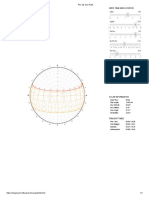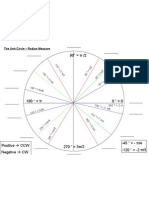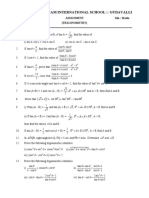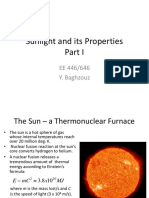Finding The Distance Between Two Polar Points Written Lesson
Finding The Distance Between Two Polar Points Written Lesson
Uploaded by
davidmorrierCopyright:
Available Formats
Finding The Distance Between Two Polar Points Written Lesson
Finding The Distance Between Two Polar Points Written Lesson
Uploaded by
davidmorrierOriginal Description:
Original Title
Copyright
Available Formats
Share this document
Did you find this document useful?
Is this content inappropriate?
Copyright:
Available Formats
Finding The Distance Between Two Polar Points Written Lesson
Finding The Distance Between Two Polar Points Written Lesson
Uploaded by
davidmorrierCopyright:
Available Formats
Distance Between Polar Points Lesson
Lesson Objectives
Learn how to find the angle between two polar points
Learn how to find the distance between two polar points
How to Find the Distance Between Two Polar Points
In this lesson, we will learn how to find the distance between points on the
polar plane. Previously, we have learned how to find the distance between two
points (x1, y1), (x2, y2) on the rectangular plane using the distance formula:
√ 2 2
d = (x2 − x1) + (y2 − y1)
Let's suppose we were asked to find the distance between two points given
with polar coordinates:
(r1, θ1), (r2, θ2)
We could convert these polar coordinates to rectangular coordinates and then
use the distance formula, however, there is a simpler approach. Let's consider
finding the distance between the two polar points:
(4, 105°), (3, 225°)
Let's plot our two points on the polar grid:
5° 90° 75°
10
0° 60
12 °
5°
45
13
°
0°
30
15
°
165°
15°
180°
1 2 3 4 5 6
θ = 0°
°
3
5
4
9
5
1
°
°
33
0
21
0°
°
3
5
1
2
5
2
0° 30
24 0°
255° 285°
270°
Let's first consider the angle between the two points:
5° 90° 75°
10
0° 60
12 °
5°
45
13
°
0°
30
15
°
165°
15°
180°
1 2 3 4 5 6
θ = 0°
°
3
5
4
9
5
1
°
°
33
0
21
0°
°
3
5
1
2
5
2
0° 30
24 0°
255° 285°
270°
We need to rotate 105° counterclockwise to get from the polar axis to the first
point (4, 105°). Additionally, we need to rotate 225° counterclockwise to get
from the polar axis to the second point. The angle between the two points
(120°) would be found by subtracting the larger angle 225° minus the smaller
angle 105°:
5° 90° 75°
10
0° 60
12 °
5°
45
13
°
0°
30
15
°
165°
15°
180°
1 2 3 4 5 6
θ = 0°
°
3
5
4
9
5
1
°
°
33
0
21
0°
°
3
5
1
2
5
2
0° 30
24 0°
255° 285°
270°
Now that we have found the angle between the two points, let's draw a line
segment connecting these two points. The length of this line segment is the
distance between the two points.
5° 90° 75°
10
0° 60
12 °
5°
45
13
°
0°
30
15
°
165°
15°
180°
1 2 3 4 5 6
θ = 0°
°
3
5
4
9
5
1
°
°
33
0
21
0°
°
3
5
1
2
5
2
0° 30
24 0°
255° 285°
270°
Now, let's form a triangle by drawing a line segment from the pole to (4, 105°)
and another from the pole to (3, 225°):
5° 90° 75°
10
0° 60
12 °
5°
45
13
°
0°
30
15
°
165°
15°
180°
1 2 3 4 5 6
θ = 0°
°
3
5
4
9
5
1
°
°
33
0
21
0°
°
3
5
1
2
5
2
0° 30
24 0°
255° 285°
270°
Consider that we have SAS, which allows us to use the law of cosines to find
our missing side length.
In any triangle ABC, with sides a, b, and c:
2 2 2
a = b + c − 2bc cos A
Let's call our unknown side a, this will be the distance between the two polar
points. The other two known sides will be b and c:
2 2 2
a = 4 + 3 − 2(4)(3) ⋅ cos120°
1
2
a = 16 + 9 − (24 ⋅ − )
2
2
a = 25 − (−12)
2
a = 37
a = √ 37
This tells us the distance between the two points (4, 105°) and (3, 225°) is
√ 37 .
Formula for Finding the Distance Between Two Polar Points
Let's now generalize our results into a nice formula.
(r1, θ1), (r2, θ2)
We will just plug into the law of cosines with r1 and r2 representing our two
known sides and the angle between the two sides will be given as (θ2 - θ1):
2 2 2
a = b + c − 2bc cos A
We will use d for distance instead of a, the unknown side length:
2 2 2
d = (r1) + (r2) − 2(r1)(r2) ⋅ cos(θ2 − θ1)
√ 2 2
d = (r1) + (r2) − 2(r1)(r2) ⋅ cos(θ2 − θ1)
Let's look at a few examples.
Example #1: Find the distance between the polar points.
(2, 120°), (4, 210°)
Let's just use the left point as the first point and the right point as the second
point. Note, the labeling doesn't matter. We will get the same answer either
way:
√ 2 2
d = 2 + 4 − 2(2)(4) ⋅ cos(210° − 120°)
d = √ 4 + 16 − (16 ⋅ cos(90°))
d = √ 20 − (16 ⋅ 0)
d = √ 20
d = 2√ 5
If we reversed the labeling, we would end up with cos(-90°).
Recall the negative angle identity for cosine:
cos(−θ) = cos θ
Therefore, we would have the same answer either way.
Example #2: Find the distance between the polar points.
7π π
(3, ), (2, )
6 2
Let's again use the left point as the first point and the right point as the second
point:
π 7π
√ 2 2
d = 3 + 2 − 2(3)(2) ⋅ cos ( − )
2 6
π 7π
d = √ 9 + 4 − (12 ⋅ cos ( − ))
2 6
3π 7π
d = √ 13 − (12 ⋅ cos ( − ))
6 6
4π
d = √ 13 − (12 ⋅ cos (− ))
6
2π
d = √ 13 − (12 ⋅ cos (− ))
3
Use the negative angle identity for cosine:
2π
d = √ 13 − (12 ⋅ cos ( ))
3
1
d = √ 13 − (12 ⋅ − )
2
d = √ 13 − (−6)
d = √ 19
When we are given a problem with a negative r-value, a negative angle, or an
angle that is larger than 360°, we can use the formula as given. If it helps, you
can also write the point in a different form with a positive radius and positive
angle between 0° (inclusive) and 360° (exclusive). Let's look at a few
examples.
Example #3: Find the distance between the polar points.
(4, −30°), (4, 210°)
For the first point, we have a negative angle. We can work with the angle as is
or we can find a coterminal angle by adding 360°. This will locate another form
of the same point. Either way, the answer will be the same. Let's try it both
ways and think about why this works.
Plug into the formula, use the left point as the first point and the right point as
the second point:
√ 2 2
d = 4 + 4 − 2(4)(4) ⋅ cos(210 − (−30))
d = √ 32 − (32 ⋅ cos(240))
1
d = √ 32 − (32 ⋅ − )
2
d = √ 32 − (−16)
d = √ 48
d = 4√ 3
Let's now work the problem in a different way. Let's find a coterminal angle for
-30° by adding 360°:
−30° + 360° = 330°
Our new polar coordinates locate the same point but now we have an angle
between 0° (inclusive) and 360° (exclusive).
(4, 330°), (4, 210°)
Plug into the formula, use the left point as the first point and the right point as
the second point:
√ 2 2
d = 4 + 4 − 2(4)(4) ⋅ cos(210° − 330°)
d = √ 16 + 16 − 32 ⋅ cos(−120°)
Use the negative angle identity for cosine:
d = √ 32 − (32 ⋅ cos(120°))
1
d = √ 32 − (32 ⋅ − )
2
d = √ 32 − (−16)
d = √ 48
d = 4√ 3
You can see that we get the same answer either way and might be wondering
why? Let's take a look at our points on the polar grid:
5° 90° 75°
10
0° 60
12 °
5°
45
13
°
0°
30
15
°
165°
15°
180°
1 2 3 4 5 6
θ = 0°
°
3
5
4
9
5
1
°
°
33
0
21
0°
°
3
5
1
2
5
2
0° 30
24 0°
255° 285°
270°
Let's think about a simple identity:
cos(360° − θ) = cos θ
We can prove this using the difference identity for cosine:
cos(360° − θ) = cos 360° cos θ + sin 360° sin θ
cos(360° − θ) = 1 cos θ + 0
cos(360° − θ) = cos θ
This tells us that it doesn't matter if we find the angle between the polar points
or the angle on the outside. The cosine value will be the same either way, so
we can use the formula with any negative angles that we come across.
Example #4: Find the distance between the polar points.
(−3, −165°), (4, 45°)
For the first point, we have a negative r-value and a negative angle. We can
work with this point as given or change it over by adding 180° to the angle and
changing the r-value to positive.
(3, 15°), (4, 45°)
Plug into the formula, use the left point as the first point and the right point as
the second point:
√ 2 2
d = 3 + 4 − 2(3)(4) ⋅ cos(45° − 15°)
d = √ 9 + 16 − 24 ⋅ cos(30°)
√3
d = 25 − (24 ⋅ )
⎷ 2
√
d = 25 − 12√ 3
If we wanted to skip the conversion, our formula would work just fine. Let's
plug in the polar points as given.
Plug into the formula, use the left point as the first point and the right point as
the second point:
√ 2 2
d = (−3) + 4 − 2(−3)(4) ⋅ cos(45 − (−165°))
d = √ 9 + 16 + 24 ⋅ cos(210°)
√3
d = 25 + (24 ⋅ − )
⎷ 2
√
d = 25 − 12√ 3
Again, let's pause for a minute and think about why this works. When we have
a negative r-value, this changes our sign in the middle part to positive. This is
countered by the fact that changing to a positive r-value means the angle is
increased by 180°. Let's think about the following identity.
cos(θ + 180°) = −cos θ
We can prove this using the sum identity for cosine:
cos(θ + 180°) = −cos θ
cos(θ + 180°) = cos θ cos 180° − sin θ sin 180°
cos(θ + 180°) = −1 ⋅ cos θ − 0
cos(θ + 180°) = −cos θ
You might also like
- Deviation CardDocument1 pageDeviation CardFroilan FrancelisoNo ratings yet
- CEC101 Structural MechanicsDocument103 pagesCEC101 Structural MechanicsAhmad Abubakar Najad100% (1)
- Trig Cheat SheetDocument4 pagesTrig Cheat SheetJASPER LEGASPINo ratings yet
- Ws Mercator Book 00-69Document70 pagesWs Mercator Book 00-69LNo ratings yet
- SKF Taperbush Taperlock Klembus Klemnaaf Catalogus Bushings Hubs Buchsen NabenDocument11 pagesSKF Taperbush Taperlock Klembus Klemnaaf Catalogus Bushings Hubs Buchsen NabenNguyễn Duy HưngNo ratings yet
- Azimuthal MapDocument1 pageAzimuthal MapvalentinabuNo ratings yet
- Azimuthal Map - TabloidDocument1 pageAzimuthal Map - TabloidJaime VillanuevaNo ratings yet
- Azimuthal Map: Center: 90°0'0"N 0°0'0"EDocument1 pageAzimuthal Map: Center: 90°0'0"N 0°0'0"EJaime VillanuevaNo ratings yet
- Azimuthal MapDocument1 pageAzimuthal MapAslanNo ratings yet
- Ex 05Document1 pageEx 05Pramod KumarNo ratings yet
- Ex 04Document1 pageEx 04Pramod KumarNo ratings yet
- D Main Field Total Intensity - Epoch 2020Document1 pageD Main Field Total Intensity - Epoch 2020pocarmensofia85No ratings yet
- Hoja PolarDocument2 pagesHoja Polarkoby bryantNo ratings yet
- ACT 1Document1 pageACT 1ana.lopez.lanuza.923No ratings yet
- Methode Unloading Tank M-2003, M-3001, M-6001 & S-6001 r1Document4 pagesMethode Unloading Tank M-2003, M-3001, M-6001 & S-6001 r1faturpionirNo ratings yet
- Practical 1 - Measurement of Length and Volume (Circus of Experiments)Document9 pagesPractical 1 - Measurement of Length and Volume (Circus of Experiments)gr5tt89zcfNo ratings yet
- Close Traverse Model2Document1 pageClose Traverse Model2hindNo ratings yet
- Sunrise'Document1 pageSunrise'KoreenNo ratings yet
- Yagi Antenna 406 To 512 MHZ: Ca7 SeriesDocument4 pagesYagi Antenna 406 To 512 MHZ: Ca7 SeriesRAMÓN RAMÍREZ LUZNo ratings yet
- Audiowell Ultrasonic Sensor 200mHzDocument2 pagesAudiowell Ultrasonic Sensor 200mHzJoseNo ratings yet
- ADU451503 - 1.6.1 - 14 - 65 - XXP ELB WB - DatasheetDocument2 pagesADU451503 - 1.6.1 - 14 - 65 - XXP ELB WB - DatasheetMartin MalýNo ratings yet
- Math F3 Chapter 6Document1 pageMath F3 Chapter 6Kriyaashini VijeyanNo ratings yet
- The Unit Circle - Radian MeasureDocument1 pageThe Unit Circle - Radian MeasureDrew Rossow100% (5)
- Charneiras PlásticasDocument1 pageCharneiras PlásticasGustavo LealNo ratings yet
- Performance Task #3.0 TrigonometryDocument3 pagesPerformance Task #3.0 TrigonometryBer HurriNo ratings yet
- General Informaction: Ignitor II® EquippedDocument4 pagesGeneral Informaction: Ignitor II® EquippedVõ Trọng ĐứcNo ratings yet
- CLIMADocument6 pagesCLIMAfranzvelasquezfNo ratings yet
- Horizontal and Vertical Radiation Pattern: Polar-LinearDocument4 pagesHorizontal and Vertical Radiation Pattern: Polar-LinearЕгор ПоляковNo ratings yet
- Carta Solar SantiagoDocument1 pageCarta Solar SantiagoDanny CarterNo ratings yet
- 1.3 Larry - PageDocument1 page1.3 Larry - Pagesrthiele624No ratings yet
- North AmericaDocument1 pageNorth AmericaDavid Eduardo Guerra GuerraNo ratings yet
- Wmm2015v2 F MercDocument1 pageWmm2015v2 F MerctabVlaeNo ratings yet
- Horizontal and Vertical Radiation Pattern: Polar-LinearDocument4 pagesHorizontal and Vertical Radiation Pattern: Polar-LinearglukkerNo ratings yet
- CS7276506 Kathrein XXXPol Panel 790-960 - 1710-2180Document2 pagesCS7276506 Kathrein XXXPol Panel 790-960 - 1710-2180Benjamin GilNo ratings yet
- 700 MHZ Dual Band 6', 85 Degree Antenna Ret: General SpecificationsDocument2 pages700 MHZ Dual Band 6', 85 Degree Antenna Ret: General SpecificationsBrianNo ratings yet
- T M 1653317271 Calculate Missing Angles On A Straight Line Differentiated Maths Activity Sheets - Ver - 1Document6 pagesT M 1653317271 Calculate Missing Angles On A Straight Line Differentiated Maths Activity Sheets - Ver - 1Nadia KhurshidNo ratings yet
- South Magnetic Pole Movement Based On Magnetic Field ModelsDocument1 pageSouth Magnetic Pole Movement Based On Magnetic Field Modelsaku selalu ada untukmuNo ratings yet
- Incidencia Solar S.ODocument1 pageIncidencia Solar S.OFernanda NavarroNo ratings yet
- Identifying Similar Polygons Education Presentation in Green White Orange Nostalgic Handdrawn StyleDocument13 pagesIdentifying Similar Polygons Education Presentation in Green White Orange Nostalgic Handdrawn Styletvdalangin017No ratings yet
- 65° Dualband Directional Antenna: General SpecificationsDocument2 pages65° Dualband Directional Antenna: General SpecificationsRicardo JulcaNo ratings yet
- Physics of Solar EnergyDocument15 pagesPhysics of Solar Energyreva_radhakrish1834No ratings yet
- Agri PivotDocument2 pagesAgri Pivotgeorge100% (1)
- Transitos Planetarios DaianaDocument1 pageTransitos Planetarios DaianacoraNo ratings yet
- Susan BoyleDocument24 pagesSusan Boyledavis mathewNo ratings yet
- Taper Bushings Technical DataDocument2 pagesTaper Bushings Technical DataAhad TNo ratings yet
- For Service Technician'S Use Only: DangerDocument5 pagesFor Service Technician'S Use Only: DangerAdam GuitianNo ratings yet
- Msc.1-Circ.1228Document25 pagesMsc.1-Circ.1228lukky prasetyoNo ratings yet
- Horoscope ChartDocument1 pageHoroscope ChartAlina RobuNo ratings yet
- Tropical Design LectureDocument14 pagesTropical Design LectureOfeliah100% (1)
- AsoleamientoDocument1 pageAsoleamientoGiordano Alonso Pino RodriguezNo ratings yet
- DICTUM Sharpening Primer ENDocument56 pagesDICTUM Sharpening Primer ENandrey k.No ratings yet
- 005100313947500a2033374b PDFDocument1 page005100313947500a2033374b PDFamaza_prodeoNo ratings yet
- Transits 9 May 2017: Geocentric Tropical Placidus Mean NodeDocument1 pageTransits 9 May 2017: Geocentric Tropical Placidus Mean Node87992uNo ratings yet
- Chapter 1 - Fundamentals-Of-VibrationDocument33 pagesChapter 1 - Fundamentals-Of-VibrationNanang Ali SutisnaNo ratings yet
- X - Mat Assignment Trigonometry 23 24Document4 pagesX - Mat Assignment Trigonometry 23 24Krishna K. SajjaNo ratings yet
- Differential Equation-WOW - DPPDocument20 pagesDifferential Equation-WOW - DPPSwapnil MandalNo ratings yet
- Properties of Sunlight - Part IDocument50 pagesProperties of Sunlight - Part IchesterpetersNo ratings yet
- s5 Chapter 3 NoteDocument14 pagess5 Chapter 3 Notemvs8hq94p2No ratings yet
- 2021 Neap Units 1 2 Exam 2 SolutionsDocument18 pages2021 Neap Units 1 2 Exam 2 Solutionsrazz681969No ratings yet
- 2023 Specialist Mathematics Examination Paper 2Document29 pages2023 Specialist Mathematics Examination Paper 2fefdesasdfaNo ratings yet
- Itc Assignment 1Document2 pagesItc Assignment 12K19 EP 090 SHIVANG ShivangNo ratings yet
- Applications and Higher OrderDocument4 pagesApplications and Higher OrderMaria Camila Nunez RondonNo ratings yet
- Laplace Transforms Practice Sheet PDFDocument3 pagesLaplace Transforms Practice Sheet PDFBilly MulengaNo ratings yet
- WTS 12 TrigonometryDocument52 pagesWTS 12 TrigonometryIamThatoNo ratings yet
- Navitron NT921-922HDI - LeafletDocument2 pagesNavitron NT921-922HDI - LeafletHarry GutierrezNo ratings yet
- Areas and Lengths in Polar Coordinates - 10.4 - SolutionsDocument13 pagesAreas and Lengths in Polar Coordinates - 10.4 - SolutionsJaselle NamuagNo ratings yet
- NCERT Solutions For Class 11 Maths Chapter 10 Straight Lines Ex 10.3Document17 pagesNCERT Solutions For Class 11 Maths Chapter 10 Straight Lines Ex 10.3hofog31426No ratings yet
- Integration by SubstitutionDocument3 pagesIntegration by SubstitutionscribdNo ratings yet
- Interpolation ProblemsDocument4 pagesInterpolation ProblemsdiwanNo ratings yet
- Algebraic Curves and Riemann SurfacesDocument453 pagesAlgebraic Curves and Riemann Surfacessistemas controlNo ratings yet
- Lecture 2 EE1MECDocument30 pagesLecture 2 EE1MECsalemalbulushi123No ratings yet
- Cambridge International A Level: Mathematics 9709/32 May/June 2022Document18 pagesCambridge International A Level: Mathematics 9709/32 May/June 2022Muhammad ShaffanNo ratings yet
- Maths Sample PaperDocument9 pagesMaths Sample PaperPonharish kumar.JNo ratings yet
- Grade 9 03-01-24Document4 pagesGrade 9 03-01-24Stephanie Grace SitonNo ratings yet
- A Predictive Model of Grinding Force in Silicon Wafer Self-Rotating GrindingDocument13 pagesA Predictive Model of Grinding Force in Silicon Wafer Self-Rotating Grindingthong.phamNo ratings yet
- Lamis Theorem Gate Notes 21Document4 pagesLamis Theorem Gate Notes 21Shashikant kumar 21ME15No ratings yet
- Unit 4 Fourier IntegralDocument6 pagesUnit 4 Fourier Integralchinoerageorge0No ratings yet
- Assignment4 40168195Document10 pagesAssignment4 40168195saumya11599No ratings yet
- JEE Advanced 2023 Revision Notes For Trigonometry - Free PDF DownloadDocument9 pagesJEE Advanced 2023 Revision Notes For Trigonometry - Free PDF DownloadpavanisagarlaNo ratings yet
- DPP (10-12) 11th J-Batch MathsDocument7 pagesDPP (10-12) 11th J-Batch MathsRaju SinghNo ratings yet
- Math p2 g11 QP Nov2020 EnglishDocument10 pagesMath p2 g11 QP Nov2020 EnglishlwandilemnyangoNo ratings yet
















































































